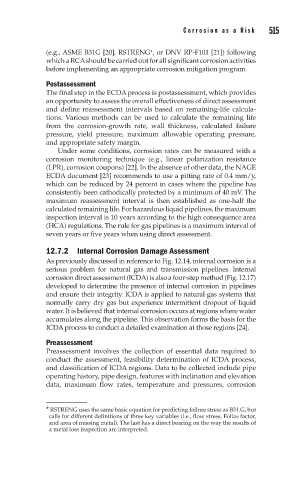Page 552 - Corrosion Engineering Principles and Practice
P. 552
514 C h a p t e r 1 2 C o r r o s i o n a s a R i s k 515
(e.g., ASME B31G [20], RSTRENG*, or DNV RP-F101 [21]) following
which a RCA should be carried out for all significant corrosion activities
before implementing an appropriate corrosion mitigation program.
Postassessment
The final step in the ECDA process is postassessment, which provides
an opportunity to assess the overall effectiveness of direct assessment
and define reassessment intervals based on remaining-life calcula-
tions. Various methods can be used to calculate the remaining life
from the corrosion-growth rate, wall thickness, calculated failure
pressure, yield pressure, maximum allowable operating pressure,
and appropriate safety margin.
Under some conditions, corrosion rates can be measured with a
corrosion monitoring technique (e.g., linear polarization resistance
(LPR), corrosion coupons) [22]. In the absence of other data, the NAGE
ECDA document [23] recommends to use a pitting rate of 0.4 mm/y,
which can be reduced by 24 percent in cases where the pipeline has
consistently been cathodically protected by a minimum of 40 mV. The
maximum reassessment interval is then established as one-half the
calculated remaining life. For hazardous liquid pipelines, the maximum
inspection interval is 10 years according to the high consequence area
(HCA) regulations. The rule for gas pipelines is a maximum interval of
seven years or five years when using direct assessment.
12.7.2 Internal Corrosion Damage Assessment
As previously discussed in reference to Fig. 12.14, internal corrosion is a
serious problem for natural gas and transmission pipelines. Internal
corrosion direct assessment (ICDA) is also a four-step method (Fig. 12.17)
developed to determine the presence of internal corrosion in pipelines
and ensure their integrity. ICDA is applied to natural gas systems that
normally carry dry gas but experience intermittent dropout of liquid
water. It is believed that internal corrosion occurs at regions where water
accumulates along the pipeline. This observation forms the basis for the
ICDA process to conduct a detailed examination at those regions [24].
Preassessment
Preassessment involves the collection of essential data required to
conduct the assessment, feasibility determination of ICDA process,
and classification of ICDA regions. Data to be collected include pipe
operating history, pipe design, features with inclination and elevation
data, maximum flow rates, temperature and pressures, corrosion
* RSTRENG uses the same basic equation for predicting failure stress as B31.G, but
calls for different definitions of three key variables (i.e., flow stress, Folias factor,
and area of missing metal). The last has a direct bearing on the way the results of
a metal loss inspection are interpreted.

